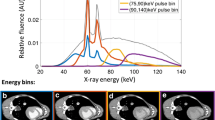Abstract
Introduction
The aim of this study is to evaluate a non-invasive method for measuring myocardial perfusion defect size in mice using a clinical single-photon emission computed tomography system equipped with pinhole collimators (pinhole SPECT).
Materials and Methods
Thirty days after ligation of the left anterior descending coronary artery, 13 mice (C57BL/6J) were imaged following intravenous injection of 370 MBq [99mTc]sestamibi. Eight control mice without myocardial infarction were likewise investigated. Image quality optimization had been achieved by repeated scanning of a multiple point phantom, with varying zoom factors, number of projection angles, and pinhole diameter. Volumetric sampling was used to generate polar maps, in which intensity was normalized to that of a standard septal region of interest (ROI), which was set at 100%. Receiver operating characteristic analyses were performed to define an optimal threshold as compared to histologically measured defect sizes, which were considered as gold standard.
Results
A spatial resolution of 1.9 mm was achieved using a pinhole diameter of 0.5 mm, a zoom factor of 2, and 6° projection angles. Histological results were best reproduced by a 60% threshold relative to the septal reference ROI. By applying this threshold, SPECT perfusion defect sizes revealed very high correlation to the histological results (R 2 = 0.867) with excellent intra- and interobserver reproducibility (intraclass correlation coefficients of 0.84 and 0.82).
Conclusions
We achieved a spatial resolution of 1.9 mm in myocardial perfusion imaging in mice using a clinical SPECT system mounted with pinhole collimators. Compared to a histological gold standard, the infarct sizes were accurately estimated, indicating that this method shows promise to monitor experimental cardiac interventions in mice.






Similar content being viewed by others
References
Deindl E, Zaruba MM, Brunner S et al (2006) G-CSF administration after myocardial infarction in mice attenuates late ischemic cardiomyopathy by enhanced arteriogenesis. FASEB J 20(7):956–958
Zaruba MM, Theiss HD, Vallaster M et al (2009) Synergy between CD26/DPP-IV inhibition and G-CSF improves cardiac function after acute myocardial infarction. Cell Stem Cell 4(4):313–323
Wu MC, Gao DW, Sievers RE, Lee RJ, Hasegawa BH, Dae MW (2003) Pinhole single-photon emission computed tomography for myocardial perfusion imaging of mice. J Am Coll Cardiol 42(3):576–582
Stegger L, Hoffmeier AN, Schafers KP et al (2006) Accurate noninvasive measurement of infarct size in mice with high-resolution PET. J Nucl Med 47(11):1837–1844
Acton PD, Thomas D, Zhou R (2006) Quantitative imaging of myocardial infarct in rats with high resolution pinhole SPECT. Int J Cardiovasc Imaging 22(3–4):429–434
Chin BB, Metzler SD, Lemaire A et al (2007) Left ventricular functional assessment in mice: feasibility of high spatial and temporal resolution ECG-gated blood pool SPECT. Radiology 245(2):440–448
Scheuermann JS, Metzler SD (2007) Measuring transverse shift parameters for pinhole SPECT using point sources at multiple radii of rotation. IEEE Trans Nucl Sci 54(5):1525–1534
Browne J, DePierro AR (1996) A row-action alternative to the EM algorithm for maximizing likelihoods in emission tomography. IEEE Trans Med Imag 15(5):687–699
Lewitt RM (1990) Multidimensional digital image representations using generalized Kaiser-Bessel window functions. J Opt Soc Am A 7(10):1834–1846
Higuchi T, Nekolla SG, Jankaukas A et al (2007) Characterization of normal and infarcted rat myocardium using a combination of small-animal PET and clinical MRI. J Nucl Med 48(2):288–294
Nekolla SG, Miethaner C, Nguyen N, Ziegler SI, Schwaiger M (1998) Reproducibility of polar map generation and assessment of defect severity and extent assessment in myocardial perfusion imaging using positron emission tomography. Eur J Nucl Med 25(9):1313–1321
Bland JM, Altman DG (1986) Statistical methods for assessing agreement between two methods of clinical measurement. Lancet 1(8476):307–310
Naidoo-Variawa S, Hey-Cunningham AJ, Lehnert W et al (2007) High-resolution imaging of the large non-human primate brain using microPET: a feasibility study. Phys Med Biol 52(22):6627–6638
Hirai T, Nohara R, Hosokawa R et al (2000) Evaluation of myocardial infarct size in rat heart by pinhole SPECT. J Nucl Cardiol 7(2):107–111
Liu Z, Kastis GA, Stevenson GD et al (2002) Quantitative analysis of acute myocardial infarct in rat hearts with ischemia-reperfusion using a high-resolution stationary SPECT system. J Nucl Med 43(7):933–939
Yukihiro M, Inoue T, Iwasaki T, Tomiyoshi K, Erlandsson K, Endo K (1996) Myocardial infarction in rats: high-resolution single-photon emission tomographic imaging with a pinhole collimator. Eur J Nucl Med 23(8):896–900
Constantinesco A, Choquet P, Monassier L, Israel-Jost V, Mertz L (2005) Assessment of left ventricular perfusion, volumes, and motion in mice using pinhole gated SPECT. J Nucl Med 46(6):1005–1011
Liang X, Sun Y, Ye M et al (2009) Targeted ablation of PINCH1 and PINCH2 from murine myocardium results in dilated cardiomyopathy and early postnatal lethality. Circulation 120(7):568–576
Richardson RB (2008) Age-dependent changes in oxygen tension, radiation dose and sensitivity within normal and diseased coronary arteries-Part A: dose from radon and thoron. Int J Radiat Biol 84(10):838–848
Cao F, Lin S, Xie X et al (2006) In vivo visualization of embryonic stem cell survival, proliferation, and migration after cardiac delivery. Circulation 113(7):1005–1014
Anger HO (1967) Radioisotope cameras. In: Hine GJ (ed) Instrumentation in nuclear medicine, vol 1. Academic, New York, pp 485–552
Metzler SD, Accorsi R (2005) Resolution- versus sensitivity-effective diameter in pinhole collimation: experimental verification. Phys Med Biol 50(21):5005–5017
Iltis I, Kober F, Dalmasso C, Lan C, Cozzone PJ, Bernard M (2005) In vivo assessment of myocardial blood flow in rat heart using magnetic resonance imaging: effect of anesthesia. J Magn Reson Imaging 22(2):242–247
Acknowledgments
A substantial part of this work originated from the doctoral thesis of Tim Wollenweber.
Author information
Authors and Affiliations
Corresponding author
Additional information
An erratum to this article can be found at http://dx.doi.org/10.1007/s11307-009-0297-x
Rights and permissions
About this article
Cite this article
Wollenweber, T., Zach, C., Rischpler, C. et al. Myocardial Perfusion Imaging is Feasible for Infarct Size Quantification in Mice Using a Clinical Single-photon Emission Computed Tomography System Equipped with Pinhole Collimators. Mol Imaging Biol 12, 427–434 (2010). https://doi.org/10.1007/s11307-009-0281-5
Received:
Revised:
Accepted:
Published:
Issue Date:
DOI: https://doi.org/10.1007/s11307-009-0281-5




